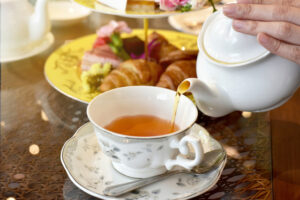Introduction
Chinese meals rarely arrive without steaming tea. Consequently, many diners wonder which blend fills their porcelain cups. This article reveals the traditional favorites, explains brewing secrets, and highlights health perks. Moreover, it helps you order like a seasoned guest.
Why Jasmine Tea Dominates
Most restaurants pour fragrant jasmine green tea. Firstly, its floral aroma pairs well with savory dishes. Secondly, the light body cleanses oil from fried foods. Additionally, jasmine leaves keep flavor stable during long service hours. Therefore, owners choose it to satisfy broad palates.
Oolong Tea Offers Complexity
However, some upscale spots favor oolong. Partially oxidized leaves yield notes of peach, honey, and roasted nut. Consequently, oolong balances spicy Sichuan staples and rich Cantonese barbecue. Furthermore, its medium caffeine level refreshes without overwhelming sensitive diners.
Pu-erh Tea Brings Earthy Depth
Meanwhile, Yunnan’s fermented pu-erh appeals to tradition-minded patrons. Aged cakes develop earthy, mellow tones that cut heavy braised pork. In addition, pu-erh aids digestion after feast-style banquets. Thus, select dim sum houses present it upon request, often in small clay pots.
Chrysanthemum Tea Delivers Floral Calm
Not every Chinese restaurant relies on camellia leaves. Chrysanthemum blossoms steep into caffeine-free golden liquor. Moreover, the delicate drink cools the body, according to herbal lore. Because of this, many Cantonese eateries serve chrysanthemum alongside deep-fried snacks, providing gentle contrast.
How Restaurants Brew for Consistency
Restaurants brew in large stainless kettles to maintain even heat. Moreover, they measure loose leaves by weight, not spoonfuls, ensuring uniform strength. After five minutes, staff decant into insulated pots. Consequently, tea avoids bitterness while staying warm between refills. Fresh water replaces leaves every two hours, preserving aroma.
Health Advantages That Diners Appreciate
Green, oolong, and pu-erh teas deliver antioxidants called catechins. Therefore, regular sippers may enjoy better heart health. Furthermore, moderate caffeine sharpens focus without jitters. In addition, herbal chrysanthemum contains apigenin, which may ease tension. Nevertheless, benefits depend on balanced consumption and overall diet.
Ordering Tips to Elevate Your Meal
Ask your server which teas are available beyond the house blend. Furthermore, request a gaiwan or small teapot if you prefer personal control. Steep green tea under 85 °C; otherwise, bitterness emerges. Conversely, let pu-erh infuse longer for full depth. Finally, decline sugar so natural notes shine.
Conclusion
Tea in Chinese restaurants is more than a warm gesture. Instead, it completes the culinary experience, harmonizing flavors while offering subtle wellness boosts. Whether you favor jasmine’s perfume, oolong’s complexity, pu-erh’s depth, or chrysanthemum’s calm, now you can choose confidently. Therefore, next time the teapot lands, savor each sip with fresh understanding.

